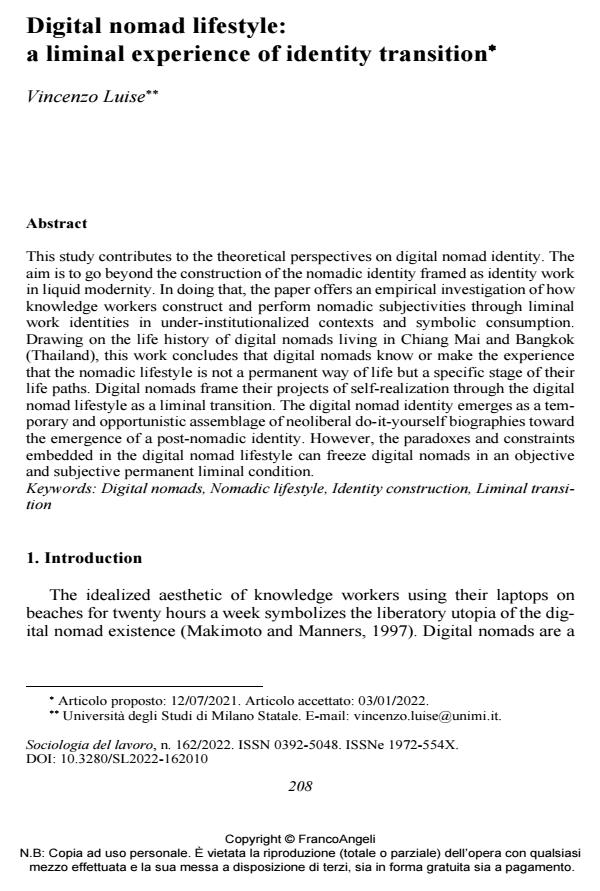Digital nomad lifestyle: a liminal experience of identity transition
Journal title SOCIOLOGIA DEL LAVORO
Author/s Vincenzo Luise
Publishing Year 2022 Issue 2022/162
Language English Pages 21 P. 208-228 File size 220 KB
DOI 10.3280/SL2022-162010
DOI is like a bar code for intellectual property: to have more infomation
click here
Below, you can see the article first page
If you want to buy this article in PDF format, you can do it, following the instructions to buy download credits

FrancoAngeli is member of Publishers International Linking Association, Inc (PILA), a not-for-profit association which run the CrossRef service enabling links to and from online scholarly content.
This study contributes to the theoretical perspectives on digital nomad identity. The aim is to go beyond the construction of the nomadic identity framed as identi-ty work in liquid modernity. In doing that, the paper offers an empirical investiga-tion of how knowledge workers construct and perform nomadic subjectivities through liminal work identities in under-institutionalized contexts and symbolic consumption. Drawing on the life history of digital nomads living in Chiang Mai and Bangkok (Thailand), this work concludes that digital nomads know or make the experience that the nomadic lifestyle is not a permanent way of life but a spe-cific stage of their life paths. Digital nomads frame their projects of self-realization through the digital nomad lifestyle as a liminal transition. The digital nomad identi-ty emerges as a temporary and opportunistic assemblage of neoliberal do-it-yourself biographies toward the emergence of a post-nomadic identity. However, the paradoxes and constraints embedded in the digital nomad lifestyle can freeze digital nomads in an objective and subjective permanent liminal condition.
Keywords: Digital nomads, Nomadic lifestyle, Identity construction, Liminal transition
- Subscription-Based Services as a Tool for Attracting Digital Nomads: Opportunities for Bulgarian Hospitality Sector Georgina Lukanova, Katina Popova, in Proceedings of the International Conference on Business Excellence /2025 pp.1027
DOI: 10.2478/picbe-2025-0081 - Welcome to ‘Dalifornia’: Chinese digital nomads as mobile entrepreneurs Kaidong Yu, Jingtong Zhang, Kevin Hannam, in Current Issues in Tourism /2025 pp.2432
DOI: 10.1080/13683500.2024.2376884 - “Home office is the here and now.” Digital nomad visa systems and remote work-focused leisure policies José Ignacio Sánchez-Vergara, Marko Orel, Ignasi Capdevila, in World Leisure Journal /2023 pp.236
DOI: 10.1080/16078055.2023.2165142
Vincenzo Luise, Digital nomad lifestyle: a liminal experience of identity transition in "SOCIOLOGIA DEL LAVORO " 162/2022, pp 208-228, DOI: 10.3280/SL2022-162010